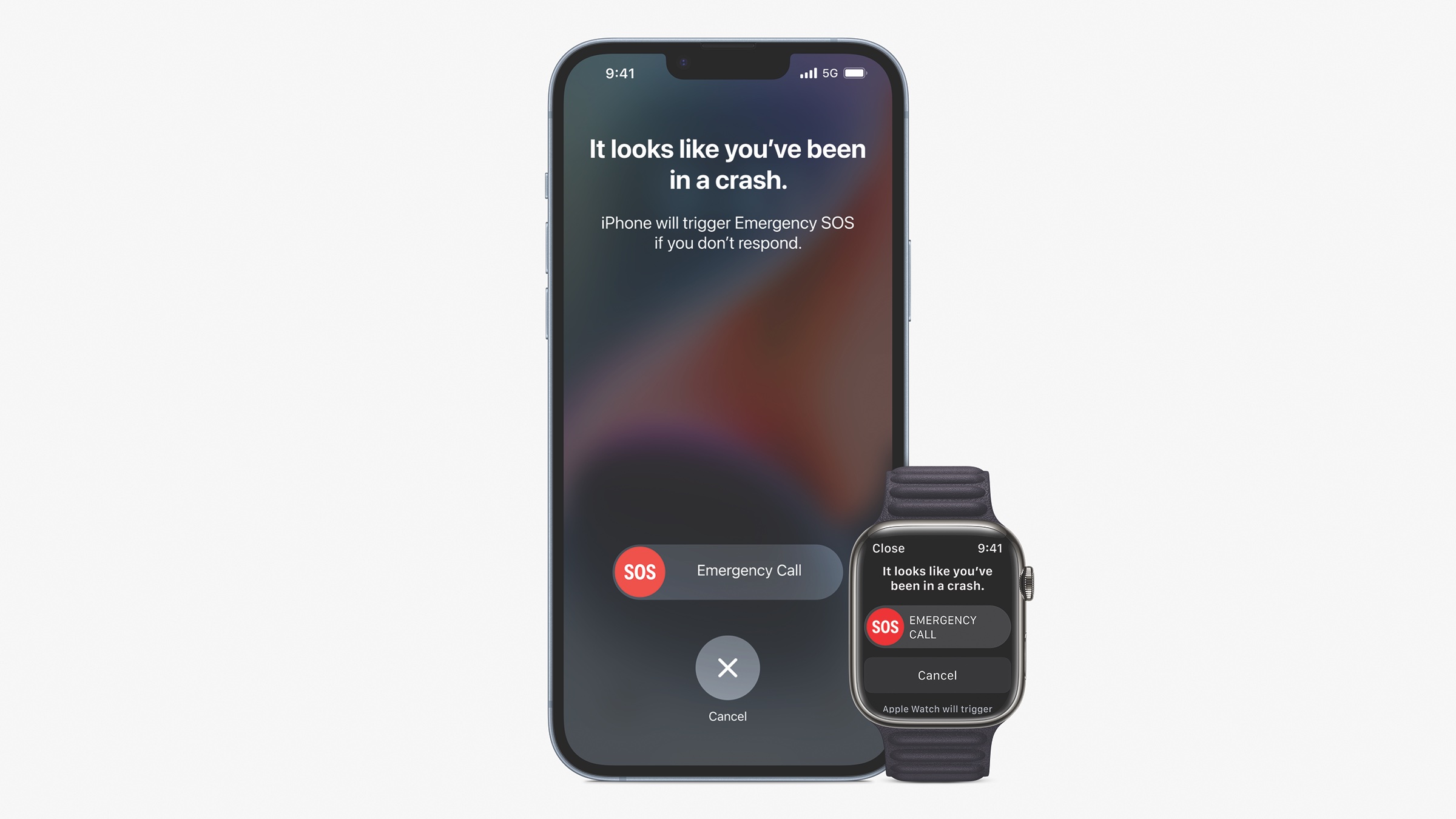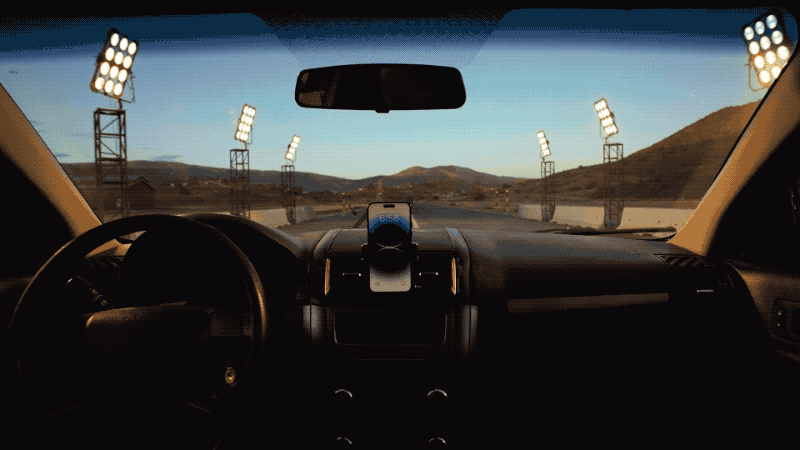Apple’s recent hardware events have been punctuated by a touch of doom and gloom. It’s a tonal shift from the usual celebratory nature of these presentations — all by design, of course. The Apple Watch was the first to the party. Features like AFib readings and Fall Detection gave way to video testimonials from users who survived close calls thanks to the wearable.
At September’s Far Out event, the company introduced another feature that falls into the category of updates you’ll hopefully never need. Crash Detection for the iPhone and Apple Watch has since proven to be something of a misunderstood addition, due in part to the fact that it’s an extremely difficult one to test.
Last week, TechCrunch sat down with a pair of Apple executives for a conversation about the feature’s ins and outs. Vice president, Sensing & Connectivity, Ron Huang, and vice president, Worldwide iPhone Product Marketing, Kaiann Drance, answered some of our burning questions about Crash Detection, to give us a better picture of what Apple’s latest safety brings to the table for iPhone and Apple Watch users.
The addition of the feature arrives in large part courtesy of a new Gyroscope and Accelerometer. “It’s mostly the G Force detection,” says Drance. It’s able to detect G Force up to 256 Gs. That was one of the key differences for the new accelerometers that the new watches and phones have.”

Image Credits: Apple
Huang adds, “It started off with our fundamental understanding of what is experienced during a crash. In these crashes, you see impact forces over 100 (Gs). We started around 256. Any time you try to increase that range, there are trade-offs, in terms of precision at the higher range and the power costs. It took the team a lot of work to build the sensors in this way.”
The new gyroscope, meanwhile, is designed to sense speed changes more quickly than the older versions. As for the myriad other ways in which the components are utilized on the devices, Apple says, “they provide the same great level of performance for other things like camera stabilization, playing games, etc.”
Ultimately, the gyroscope and accelerometer are just two of the sensor pieces here. The list also includes the GPS to determine that the user is traveling at high speeds, the microphone to monitor for the sounds of a crash and the barometer, which detects the change in pressure that occurs when airbags are deployed. Not all of the systems have to collect associated data to trigger the system. For example, if the car’s windows are down, the change in barometric pressure will be too subtle to impact the reading.
“There’s no silver bullet, in terms of activating crash detection,” says Huang. “It’s hard to say how many of these things have to trigger, because it’s not a straight equation. Depending how fast the traveling speed was earlier, determines what signals we have to see later on, as well. Your speed change, combined with the impact force, combined with the pressure change, combined with the sound level, it’s all a pretty dynamic algorithm.”
The system does, however, need to detect multiple data points at once, so simply dropping the phone in a moving car shouldn’t accidentally trigger the feature.

Image Credits: Apple
“I actually had a rear-end fender bender when I was in New York earlier,” says Drance. “My crash detection did not go off, because it’s just one of those minor things where you just get out of your car and keep going. That’s part of the sensor fusion and accuracy, because we don’t want to be doing a lot of false calls to 9-1-1 when they’re not necessary.”
The company notes that the feature isn’t specifically designed for something like — god forbid — a train crash, though it adds that other features like Fall Detection have been used for cases outside their initial design. “We think Crash Detection could potentially be that, too,” says Huang.
Bluetooth and Carplay are also used to determine that you’re in a car, though neither are strictly necessary for the feature. “On top of that, we added a lot of signals,” says Huang. “Whether it’s road noise or engine noise, we can see that. We can see that the Wi-Fi routers that you’re using are changing very rapidly — faster than if you’re walking or biking and so forth.”
Apple worked with a number of crash labs to gather the necessary data and perform real-world testing, in order to assure an acceptable level of efficacy for the feature. It’s intentionally difficult to trigger outside the intended scenario, so you don’t accidentally call emergency services. That also goes for if your phone accidentally falls from the mount while driving, or even a less severe crash.
“We put iPhones in many different places throughout the car — on the dummies and the car itself and mounts and so forth,” says Huang. “And then we collect all of the raw sensor data coming from these devices during such a crash. We put cameras inside and outside the cars, as well, so from the footage, you can time the actual impact, what the pressure sensors see when the airbag goes off in slow motion. We’re able to look at data in high fidelity. We also look at DATA from the Department of Transportation or the NHTSA (National Highway Traffic Safety Administration) to understand what kinds of crashes are the leading causes of injuries.”

Image Credits: Apple
The company didn’t offer an exact number of car crashes that were required to create the final dataset, but did imply that it was more than “dozens” and added that “thousands” of its own devices were used in the process. Apple says such real-world crashes are difficult to simulate, particularly ones that can check off the necessary boxes.
It’s easy to see how the system might be the most valuable to drivers in rural areas. After all, getting into a crash in a more populated area significantly increases the chances of someone nearby being around to report the accident. In a more remote area — especially in the case when it’s a one-party crash involving an object like a tree — the feature could be a potential lifesaver.
However, much like bystanders, wireless signals can be harder to come by in such areas.

Image Credits:
“Just like any 9-1-1 call, we would attempt to dial it first over your network. If your network is not available, we will try to route to any other available carrier, even if it’s not the carrier that you have with your SIM. When there’s no coverage, this will be linked to the emergency SOS via satellite feature. If you happen to get into an accident like that, and there’s absolutely no coverage where you are, we will still try to connect via satellite through the emergency SOS capability.”
Asked whether there are any differences in accuracy between the phone and watch, Apple only says “they’re both very accurate.” Huang adds, “There are differences. Watch is on your wrist, and the kind of impact you see on your wrist during a crash will be very different. There are those differences, but, for example, barometer is very similar with the iPhone and Watch. So there are differences based on how the devices are used, placed or worn.”
The feature is available for iPhone 14 and 14 Pro models, along with the Apple Watch Series 8 and Ultra.
Apple offers a deeper dive into crash detection by Brian Heater originally published on TechCrunch















 English (US) ·
English (US) ·